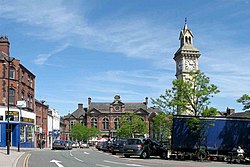Tunstall: Difference between revisions
Created page with '{{Infobox town | name = Tunstall | county = Staffordshire | picture=Tunstall tower square.jpg | picture caption=Tunstall Tower Square | os grid ref = SJ864516 | latitude = 53.057…' |
m Wording of lead |
||
| Line 16: | Line 16: | ||
'''Tunstall''' is the northernmost of the six towns which make up [[Stoke-on-Trent]], [[Staffordshire]]. Of the Six Towns it is the northernmost. | '''Tunstall''' is the northernmost of the six towns which make up [[Stoke-on-Trent]], [[Staffordshire]]. Of the Six Towns it is the northernmost. | ||
Tunstall | The homes of Tunstall lie largely in rows of terraced houses which were a common feature when the pottery industry was in its boom and they housed the factory workers. There are a number of new estates that have been built in the area. | ||
A recognisable Tunstall features in the novels of Arnold Bennett. | A recognisable Tunstall features in the novels of Arnold Bennett. | ||
Tunstall was the latter home to the independent | Tunstall was the latter home to the independent Frink School of Figurative Sculpture, which occupied a fine old factory (and former Old Court) in Roundwell Street for a number of years until about 2004. The Frink School was named after Elisabeth Frink, British Sculptor, and was a small intimate academy with a specific discipline of study closer in spirit to a ''master and apprentice'' structure than an educational institution. | ||
==History== | ==History== | ||
Latest revision as of 21:57, 9 December 2010
| Tunstall | |
| Staffordshire | |
|---|---|
 Tunstall Tower Square | |
| Location | |
| Grid reference: | SJ864516 |
| Location: | 53°3’26"N, 2°12’31"W |
| Data | |
| Post town: | Stoke-on-Trent |
| Postcode: | ST6 |
| Dialling code: | 01782 |
| Local Government | |
| Council: | Stoke-on-Trent |
| Parliamentary constituency: |
Stoke-on-Trent North |
Tunstall is the northernmost of the six towns which make up Stoke-on-Trent, Staffordshire. Of the Six Towns it is the northernmost.
The homes of Tunstall lie largely in rows of terraced houses which were a common feature when the pottery industry was in its boom and they housed the factory workers. There are a number of new estates that have been built in the area.
A recognisable Tunstall features in the novels of Arnold Bennett.
Tunstall was the latter home to the independent Frink School of Figurative Sculpture, which occupied a fine old factory (and former Old Court) in Roundwell Street for a number of years until about 2004. The Frink School was named after Elisabeth Frink, British Sculptor, and was a small intimate academy with a specific discipline of study closer in spirit to a master and apprentice structure than an educational institution.
History
Historians have found that iron was being produced in the town as far back as 1280. It stands on a ridge surrounded by old tilemaking and brickmaking sites, some of which probably date back to the late Middle Ages.
Tunstall was served by a railway station which was opened by the North Staffordshire Railway on December 1, 1873.
Trade Journals
1828 journal:
TUNSTALL is a considerable village within the township of Tunstall Court, a liberty in the parish of Woolstanton, four miles from Newcastle, pleasantly situated on an eminence, deriving its name from the Saxon word, tun or ton, a town, and stall, an elevated place, seat or station." "In this township abounds coal, ironstone, marl and fine cannel coal; and the manufactories of earthenware are very extensive here.
Potters
Famous potters located in the town have been the Adams dynasty of potters as well as Alfred Meakin, Booths and Enoch Wedgwood. Decorative ceramic tiles are still made in Tunstall by H and R Johnson-Richards Tiles Ltd. Jabez Vodrey too was a potter of Tunstall though more famed for his work in America.